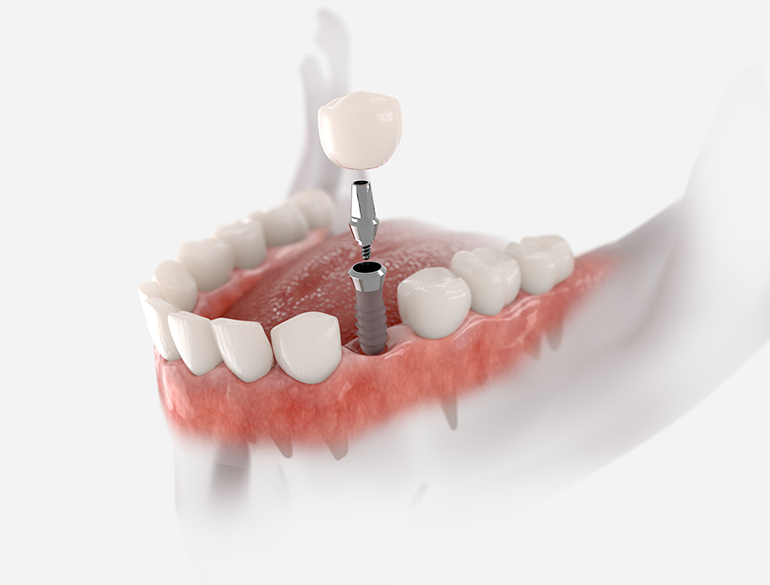An Unbiased View of Dental Sense
An Unbiased View of Dental Sense
Blog Article
Dental Sense Can Be Fun For Everyone
Table of ContentsThe Best Guide To Dental SenseThe Dental Sense PDFsWhat Does Dental Sense Mean?8 Simple Techniques For Dental Sense
are clinical tools operatively dental implanted into the jaw to restore a person's ability to eat or their look. They give assistance for artificial (phony) teeth, such as crowns, bridges, or dentures. When a tooth is shed as a result of injury or condition, an individual can experience issues such as fast bone loss, faulty speech, or modifications to chewing patterns that cause pain.Oral implant systems include an oral implant body and oral implant abutment and might additionally consist of an abutment addiction screw. Professional teeth whitening. The dental implant body is operatively placed in the jawbone in location of the tooth's origin. The oral implant abutment is usually attached to the dental implant body by the abutment addiction screw and prolongs via gum tissues into the mouth to support the attached artificial teeth
(https://dentalsense.godaddysites.com/f/transform-your-smile)Framework of The Oral Implant System picking oral implants, talk with your oral service provider about the prospective benefits and risks, and whether you are a candidate for the procedure. Points to consider: Your overall health is an important consider identifying whether you are a good candidate for dental implants, the length of time it will require to recover, and for how long the dental implant might remain in place.
Cigarette smoking may affect the healing procedure and reduce the long-lasting success of the implant. The recovery procedure for the implant body might take numerous months or longer, throughout which time you commonly have a momentary abutment instead of the tooth. the oral implant procedure: Thoroughly follow the dental hygiene instructions offered to you by your dental company.
The Definitive Guide for Dental Sense
Implant failure can cause the requirement for another procedure to take care of or replace the implant system. Brings back the ability to chew Recovers cosmetic look Aids keep the jawbone from reducing due to bone loss Protects the wellness of the surrounding bone and periodontals Aids keep nearby (nearby) teeth stable Improves lifestyle Damages to surrounding natural teeth throughout dental implant placement Injury to the surrounding tissues throughout surgery, such as sinus opening Injury throughout surgical procedure (for example, fracture of bordering jawbone) Poor function, such as feeling like the teeth do not bite with each other normally A feeling that the tooth hangs or turning in position resulting from an abutment screw loosening Implant body failure (looseness of the implant body) because of systemic infection, which might be more probable in patients with uncontrolled diabetics issues because of regional infection in bone and gum tissues sustaining the dental implant body because of postponed recovery, which might be much more likely in clients who smoke Problem cleansing the gum tissues around the dental implant, leading to inadequate dental health Untreated periodontal disease Post-surgical numbness due to nerve impingement or damages Always notify health treatment service providers and imaging service technicians that you have dental implants before any magnetic resonance imaging (MRI) or x-ray treatments.
FDA is not knowledgeable about any kind of damaging occasions reported for MRI or x-ray procedures with dental implants. Dental implants systems are typically made of products that comply with worldwide consensus criteria of the International Company for Standardization (ISO) or ASTM International. These requirements have details of what makes a safe product.

An oral implant is a structure that changes a missing tooth. With screw-like gadgets, the surgeon inserts a dental implant right into the jawbone, and it acts as a support for an artificial tooth, called a crown. A gadget called a joint connects the man-made tooth to the oral implant. The crown is customized to fit the individual's mouth and match the color of their teeth.
The Ultimate Guide To Dental Sense
Some people are not qualified for oral implant surgical treatment. It is for dental specialists to run on individuals with: severe illnessuncontrollable metabolic diseasebone or soft cells condition or infectionIf these problems are solved, an individual can have the surgery. In, dental doctors avoid operating on individuals with: If people with any of the above undertake dental implant surgical procedure, there is a greater risk of the implant falling short.

Oral dental implant surgical treatment is an individualized procedure. It's not the same for everyone. But the following provides a general overview of what you can expect your dental professional, dental specialist, periodontist or prosthodontist to do: Put the dental implant operatively. Provide you time to recover. Attach the post and final crown, bridge or denture.
Next, your surgeon will very carefully put the dental implant into your jaw. If your dental implant is near the front of your mouth, your dental practitioner will certainly make a short-lived tooth for you to put on till you heal.
Some Known Questions About Dental Sense.
Your provider can inform you what to expect why not find out more in your circumstance. During the healing stage, your jawbone should fuse to the oral implant. This process, called osseointegration, is crucial for security and lasting success. This process can take anywhere from three to 9 months. Sometimes, it might take longer.
Once your dental implant heals, your dental expert can attach the abutment (little connector message) and your last remediation (crown, bridge or denture). This generally takes regarding one hour to finish and may need a 2nd minor surgical treatment. You shouldn't really feel any pain throughout your oral implant treatment since your provider will utilize medication to numb your gum tissues.
Report this page